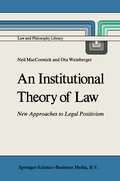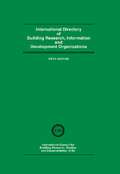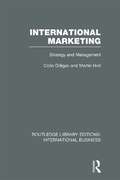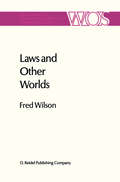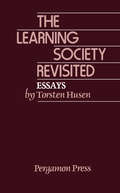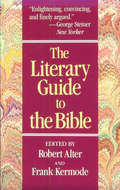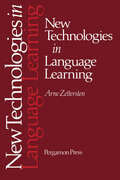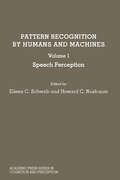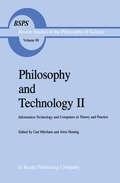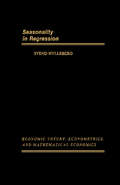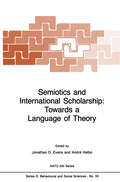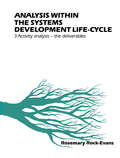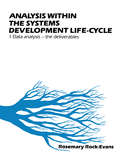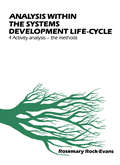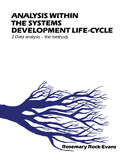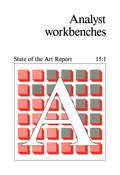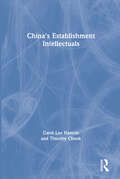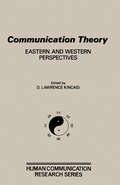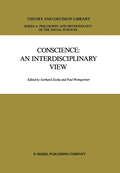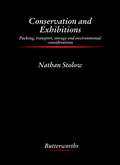- Table View
- List View
An Institutional Theory of Law: New Approaches to Legal Positivism (Law and Philosophy Library #3)
by N. MacCormick Ota WeinbergerInternational Directory of Building Research Information and Development Organizations
by International Council for Building Research, Studies and DocumentationEvery entry follows a standard pattern: after the address and telephone number of the institution there is a brief description of its history and financial support, followed by the names of the senior staff, total number of staff, the institution's structure and services, its main research programmes and a list of its publications. For this new edition a subject index has been added, allowing the reader to identify centres of research activity on individual construction topics throughout the world. The world-wide investment in construction industry research is enormous. This unique directory is a guidebook to that investment which will enable its readers to isolate sources of advice on practical problems, information on national standards and requirements and potential research collaborators.
International Directory of Building Research Information and Development Organizations
by International Council for Building Research, Studies and DocumentationEvery entry follows a standard pattern: after the address and telephone number of the institution there is a brief description of its history and financial support, followed by the names of the senior staff, total number of staff, the institution's structure and services, its main research programmes and a list of its publications. For this new edition a subject index has been added, allowing the reader to identify centres of research activity on individual construction topics throughout the world. The world-wide investment in construction industry research is enormous. This unique directory is a guidebook to that investment which will enable its readers to isolate sources of advice on practical problems, information on national standards and requirements and potential research collaborators.
International Marketing: Strategy and Management (Routledge Library Editions: International Business)
by Colin Gilligan Martin HirdThis book is a basic text for international marketing courses. It introduces the different elements of the international marketing mix and sets these in context. It discusses the firm’s strategic position: how it is orientated at present to take advantage of international marketing opportunities and how its strategy is developing. It: Stresses the wide differences between different overseas markets and the importance of handling sensitively particular local features. Examines the need to structure the whole business organisation in the right way and make international marketing effective Discusses the importance of communication and control Throughout case studies are used to highlight particular issues.
International Marketing: Strategy and Management (Routledge Library Editions: International Business)
by Colin Gilligan Martin HirdThis book is a basic text for international marketing courses. It introduces the different elements of the international marketing mix and sets these in context. It discusses the firm’s strategic position: how it is orientated at present to take advantage of international marketing opportunities and how its strategy is developing. It: Stresses the wide differences between different overseas markets and the importance of handling sensitively particular local features. Examines the need to structure the whole business organisation in the right way and make international marketing effective Discusses the importance of communication and control Throughout case studies are used to highlight particular issues.
Laws and other Worlds: A Humean Account of Laws and Counterfactuals (The Western Ontario Series in Philosophy of Science #31)
by Fred WilsonThe Learning Society Revisited
by Torsten HusenTorsten Husén has brought together in this volume a collection of his own essays, the topics of which reflect his long and distinguished career both as an academic and as a practical researcher. The essays are grouped under six main themes on which he has worked over the years: research and policy making; educational reforms; equality and meritocracy; the impact of education on career; international and comparative dimensions; and present trends and future perspectives. An underlying message running throughout the volume is the importance of examining educational problems from a wide social perspective, rather than solely from the narrow confines of the classroom.
The Literary Guide to the Bible
by Robert Alter and Frank KermodeRediscover the incomparable literary richness and strength of a book that all of us live with an many of us live by. An international team of renowned scholars, assembled by two leading literary critics, offers a book-by-book guide through the Old and New Testaments as well as general essays on the Bible as a whole, providing an enticing reintroduction to a work that has shaped our language and thought for thousands of years.
New Technologies in Language Learning
by A. ZetterstenThis is the first book to provide a comprehensive survey of the use of new technologies in language learning. In order to explain how new technologies open up possibilities for language learning, numerous practical experiments made with various electronic media are analysed. They include the use of microcomputers, videotex (viewdata), teletext, video and videodiscs. In addition, artificial intelligence, synthetic speech, robots, distance education, language testing as well communicative training and the problem of accuracy and fluency are dealt with.
Pattern Recognition by Humans and Machines: Speech Perception
by Eileen C. Schwab Howard C. NusbaumPattern Recognition by Humans and Machines, Volume 1: Speech Perception covers perception from the perspectives of cognitive psychology, artificial intelligence, and brain theory. The book discusses on the research, theory, and the principal issues of speech perception; the auditory and phonetic coding of speech; and the role of the lexicon in speech perception. The text also describes the role of attention and active processing in speech perception; the suprasegmental in very large vocabulary word recognition; and the adaptive self-organization of serial order in behavior. The cognitive science and the study of cognition and language are also considered. Psychologists will find the book invaluable.
Philosophy and Technology II: Information Technology and Computers in Theory and Practice (Boston Studies in the Philosophy and History of Science #90)
by AloisHuning CarlMitchamUntil recently, the philosophy and history of science proceeded in a separate way from the philosophy and history of technology, and indeed with respect to both science and technology, philosophical and historical inquiries were also following their separate ways. Now we see in the past quarter-century how the philosophy of science has been profoundly in fluenced by historical studies of the sciences, and no longer concerned so single-mindedly with the analysis of theory and explanation, with the re lation between hypotheses and experimental observation. Now also we see the traditional historical studies of technology supplemented by phi losophical questions, and no longer so plainly focussed upon contexts of application, on invention and practical engineering, and on the mutually stimulating relations between technology and society. Further, alas, the neat division of intellectual labor, those clearly drawn distinctions be tween science and technology, between the theoretical and the applied, between discovery and justification, between internalist and externalist approaches . . . all, all have become muddled! Partly, this is due to internal revolutions within the philosophy and his tory of science (the first result being recognition of their mutual rele vance). Partly, however, this state of 'muddle' is due to external factors: science, at the least in the last half-century, has become so intimately connected with technology, and technological developments have cre ated so many new fields of scientific (and philosophical) inquiry that any critical reflection on scientific and technological endeavors must hence forth take their interaction into account.
The Princeton Companion to Classical Japanese Literature
by Earl Roy Miner Robert E. Morrell Hiroko OdagiriThe description for this book, The Princeton Companion to Classical Japanese Literature, will be forthcoming.
Seasonality in Regression
by Svend HyllebergSeasonality in Regression presents the problems of seasonality in economic regression models. This book discusses the procedures that may have application in practical econometric work.Organized into eight chapters, this book begins with an overview of the tremendous increase in the computational capabilities made by the development of the electronic computer that has profound implications for the way seasonality is handled by economists. This text then examines some seasonal models and their characteristics. Other chapters consider the most frequently applied evaluation criteria and appraise the values in the applications. This book discusses as well the frequency domain estimators and provides insight into problems of estimating the disturbance–covariance matrix through the use of the disturbance spectrum. The final chapter deals with the main objective of the treatment of personality to formulate and estimate econometric models.This book is a valuable resource for economists and econometricians who have knowledge of econometrics at an advanced undergraduate or graduate level.
Semiotics and International Scholarship: Towards a Language of Theory (NATO Science Series D: #33)
by Jonathan D. Evans André HelboProceedings of the NATO Advanced Study Institute, Estoril, Portugal, September 18-30, 1983
Working Drawings Handbook
by Keith StylesWorking Drawings Handbook focuses on the principles, styles, methodologies, and approaches involved in drawings. The book first takes a look at the structure of information, types of drawing, and draftsmanship. Discussions focus on dimensioning, drawing conventions, techniques, materials, drawing reproduction, location drawing, component and sub-component drawings, assembly drawing, schedule, pictorial views, and structure of working drawings. The manuscript then ponders on working drawing management and other methods. Topics include planning the set, drawing register, drawing office programming, and introducing new methods. Building elements and external features, conventions for doors and windows, symbols indicating materials, electrical, telecommunications, and fire symbols, and non-active lines and symbols are also discussed. The book is a fine reference for draftsmen and researchers interested in studying the elements of drawing.
Analysis within the Systems Development Life-Cycle: Book 3 Activity Analysis — The Deliverables
by Rosemary Rock-EvansAnalysis within the Systems Development Life-Cycle, Book 3: Activity Analysis — The Deliverables provides a comprehensive coverage of the deliverables of activity analysis. The book also details purpose of each deliverable in the context of the next tasks in the systems development cycle (SDC). The text first covers the concept of deliverables and the benefits of making deliverables visible. In the second chapter, the book introduces the main concepts and diagrammatic techniques of activity analysis. The third chapter deals with the important classes or categories of concept, while the fourth chapter talks about the deliverables of activity analysis. The book will be of great use to individuals involved in the design and management of complex development projects, such as systems engineers.
Analysis within the Systems Development Life-Cycle: Data Analysis — The Deliverables
by Rosemary Rock-EvansAnalysis within the Systems Development Life-Cycle: Book 1, Data Analysis—The Deliverables provides a comprehensive treatment of data analysis within the systems development life-cycle and all the deliverables that need to be collected in analysis. The purpose of deliverables is explained and a number of alternative ways of collecting them are discussed. This book is comprised of five chapters and begins with an overview of what ""analysis"" actually means, with particular reference to tasks such as hardware planning and software evaluation and where they fit into the overall cycle. The next chapter introduces the main concepts that will be used throughout the rest of the book, along with the main diagrammatic techniques that will be used to represent the deliverables. The discussion then turns to important categories of concept; what facts to collect about entity types; what facts to collect about attribute types; and the deliverables of the data design part of the systems development cycle. The final chapter summarizes all the deliverables and puts them into the context of the systems development cycle by describing the ""systems engine""—the ""meta-model"" of the systems development life-cycle. This monograph will be of interest to systems analysts and designers.
Analysis within the Systems Development Life-Cycle: Book 4 Activity Analysis—The Methods
by Rosemary Rock-EvansAnalysis within the Systems Development Life-Cycle: Book 4, Activity Analysis—The Methods describes the techniques and concepts for carrying out activity analysis within the systems development life-cycle. Reference is made to the deliverables of data analysis and more than one method of analysis, each a viable alternative to the other, are discussed. The ""bottom-up"" and ""top-down"" methods are highlighted. Comprised of seven chapters, this book illustrates how dependent data and activities are on each other. This point is especially brought home when the task of inventing new business activities is discussed, and the data model is changed with completely new entity types—the invention of the user and analyst being added—and ""old"" entity types being removed when the activities of the business are changed. The relevance of PROLOG, LISP, knowledge bases, and expert systems is considered, and these areas of interest are brought together into the fold of ""conventional"" systems development. Finally, this text shows how the ""rules"" of the knowledge base and the ""deduction"" clauses are directly related to the activity concepts. This monograph will be a valuable resource for systems analysts and designers and those who are involved in expert systems.
Analysis Within the Systems Development Life-Cycle: Book 2 Data Analysis — The Methods
by Rosemary Rock-EvansAnalysis within the Systems Development Life-Cycle: Book 2, Data Analysis—The Methods describes the methods for carrying out data analysis within the systems development life-cycle and demonstrates how the results of fact gathering can be used to produce and verify the analysis deliverables. A number of alternative methods of analysis other than normalization are suggested. Comprised of seven chapters, this book shows the tasks to be carried out in the logical order of progression—preparation, collection, analysis of the existing system (which comprises the tasks of synthesis, verification, and approval)—and in each case how the input from the previous task is converted to the output for the next task until the final output—the verified approved deliverables—is obtained. The first chapter puts analysis into its place in the Systems Development Cycle (SDC) and explains what analysis really means. The next chapters cover, in logical sequence of dependency, the actual tasks of data analysis. The advantages and disadvantages of each method are described in the context of the life-cycle as a whole and in terms of the reliability of raw input, time problems, and so on. Each of the data models obtained using the different methods can be combined and subsequently refined using a number of step-by-step checks. The final chapter shows how the meta-model can be expanded by considering the intermediate outputs of the tasks of data analysis. This text will be of interest to systems analysts and designers and those who are involved in expert systems.
Analyst Workbenches: State of The Art Report
by R. Rock-EvansAnalyst Workbenches examines various aspects of analyst workbenches and the tasks and data that they should support. The major advances and state of the art in analyst workbenches are discussed. A comprehensive list of the available analyst workbenches, both the experimental and the commercial products, is provided. Comprised of three parts, this book begins by describing International Computers Ltd's approach to automating analysis and design. It then explains what business analysis really means, outlines the principal features of analyst workbenches, and considers the ways in which they can solve the problems. The following chapters focus on how the analyst can deal with performance issues and lay proper foundations for the later, more detailed, work of the designer; the use of artificial intelligence techniques in workbenches; and strategic information systems planning technology. Integrated Project Support Environments (IPSEs) and the workbench-related phenomenon of mapping are also discussed. The final chapter evaluates future prospects for workbench products. This monograph will be a valuable resource for systems analysts and designers.
China's Establishment Intellectuals
by Carol Lee Hamrin Timothy CheekFirst published in 1987. This book is part of an ongoing intellectual project—to understand how a changing Chinese Marxism both reflects and shapes the lives of the intelligentsia in China.
China's Establishment Intellectuals
by Carol Lee Hamrin Timothy CheekFirst published in 1987. This book is part of an ongoing intellectual project—to understand how a changing Chinese Marxism both reflects and shapes the lives of the intelligentsia in China.
Communication Theory: Eastern and Western Perspectives
by D. Lawrence KincaidCommunication Theory: Eastern and Western Perspectives focuses on the processes, methodologies, principles, and approaches involved in communication theory. The selection first elaborates on Asian perspectives on communication theory; Chinese philosophy and contemporary human communication theory; communication in Chinese narrative; and contemporary Chinese philosophy and political communication. Discussions focus on the structure and function of China's political communication system; philosophical principles of Chinese communism; embodiment of reason in experience; and dialectic completion of relative polarities. The text then examines Korean philosophy and communication, practice of Uye-Ri in interpersonal relationships, and the teachings of Yi Yulgok. The publication examines the double-swing model of intercultural communication between the East and the West; interpersonal cognition, message goals, and organization of communication; and the convergence theory of communication, self-organization, and cultural evolution. The book also ponders on the practice of Antyodaya in agricultural extension communication in India and communication within Japanese business organizations. The selection is a valuable reference for researchers interested in the Eastern and Western perspectives of communication theory.
Conscience: Salzburg Colloquium on Ethics in the Sciences and Humanities (Theory and Decision Library A: #1)
by G. Zecha P. WeingartnerValue change and uncertainty about the validity of traditional moral convictions are frequently observed when scientific re search confronts us with new moral problems or challenges the moral responsibility of the scientist. Which ethics is to be relied on? Which principles are the most reasonable, the most humane ones? For want of an appropriate answer, moral authorities of ten point to conscience, the individual conscience, which seems to be man's unique, directly accessible and final source of moral contention. But what is meant by 'conscience'? There is hardly a notion as widely used and at the same time as controversial as that of conscience. In the history of ethics we can distinguish several trends in the interpretation of the concept and function of conscience. The Greeks used the word O"uvEt81lm~ to denote a kind of 'accompa nying knowledge' that mostly referred to negatively experienced behavior. In Latin, the expression conscientia meant a knowing together pointing beyond the individual consciousness to the common knowledge of other people. In the Bible, especially in the New Testament, O"uvEt81l0"t~ is used for the guiding con sciousness of the morality of one's own action.
Conservation and Exhibitions
by VASTAConservation and Exhibitions: Packing, Transport, Storage, and Environmental Considerations presents the theory and practice in exhibitions conservation. The book aims to promote better conservation practices and less wear and tear of works of art. Topics discussed in the book include conservation principles, examining and reporting a work of art's structural stability, preparation and handling, and storage. Traditional and newer packing techniques, case and container design and construction, transportation modes, strategies and equipment, and loan agreements and insurance are also covered in detail.Conservator practitioners, exhibition organizers, technicians, and transportation specialists will find the book very useful.
